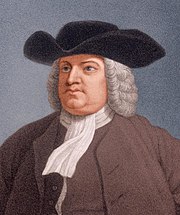| Penn v Lord Baltimore | |
|---|---|
 | |
| Court | Chancery |
| Full case name | Penn v Lord Baltimore |
| Decided | 15 May 1750 |
| Citations | (1750) 1 Ves Sen 444 27 ER 1132 [1774] All ER Rep 99 11 Digest (Repl) 377, 407 |
| Transcript | CommonLII |
| Case history | |
| Prior actions | (1745) Ridg t H 332 27 ER 847 |
| Court membership | |
| Judge sitting | Lord Hardwicke LC |
| Keywords | |
| |
Penn v Lord Baltimore (1750) 1 Ves Sen 444 was a judicial decision of Lord Hardwicke LC in relation to the long-running Penn–Calvert boundary dispute.[1]
The case is important both as a legal precedent under English law (in relation to the extent to which the English courts may act in relation to matters involving title to foreign land),[2][3][4] but also as an event in its own right during a formative period of the pre-history of the United States.[5][6]
The decision helped end the 85-year dispute over the Pennsylvania–Maryland border,[7] although the issue was not definitively resolved until King George III formally approved the newly surveyed Mason–Dixon boundaries in 1768. Ironically, just seven years later the American Revolution occurred, and both parties essentially lost all of the lands they had been arguing over for so long.
- ^ "Penn v Lord Baltimore (1750)". Swarb.co.uk. Retrieved 29 June 2020.
- ^ Cite error: The named reference
Briggswas invoked but never defined (see the help page). - ^ Dicey, p. 23-042.
- ^ Cheshire, p. 487.
- ^ Nathan, Roger E. East of the Mason-Dixon Line: A History of the Delaware Boundaries. Delaware Public Archives. p. 68. Archived from the original on 2 April 2017. Retrieved 20 March 2015.
- ^ Cite error: The named reference
brevwas invoked but never defined (see the help page). - ^ Hayes, Carroll. "Penn vs. Baltimore: A Brief For The Penns". Pennsylvania History: A Journal of Mid-Atlantic Studies: 278. Retrieved 30 June 2020.